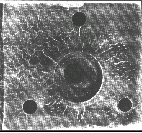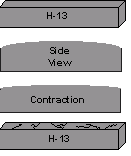 Badger Metal Tech’s continued association with NADCA’s Die Materials Committee has given us considerable insight into some of the problems and possible solutions that are being addressed by
this group of dedicated people and organizations. One of the most costly of these is the premature failure of die cast die tooling. This is so much of a concern that the focus of the Die Materials Committee is dedicated to addressing just this issue - IMPROVING THE LIFE OF DIE MATERIALS. Badger Metal Tech’s continued association with NADCA’s Die Materials Committee has given us considerable insight into some of the problems and possible solutions that are being addressed by
this group of dedicated people and organizations. One of the most costly of these is the premature failure of die cast die tooling. This is so much of a concern that the focus of the Die Materials Committee is dedicated to addressing just this issue - IMPROVING THE LIFE OF DIE MATERIALS.
A number of avenues present themselves as a result of this focus, however, it would be impossible to address all of these in this condensed bulletin. Instead, in this and the following special issues, we will focus on a discussion of the modes and causes of die failure in an attempt to further educate the die casting community and at the same time offer some
solutions that are readily available using current technology and procedures.
To do this and remove a couple of variables from the equation, it is necessary to make a few assumptions1) The proper H-13 material has been selected using the current#207-90 specification. 2) The EDM and/or machining of the tool has been properly accomplished and the white cast layer has been removed.3) The heat
treatment has been certified to conform to NADCA specifications to not only attain correct hardness but also optimum charpy impact values. These three items are extremely critical in providing maximum tool life. If compromised, everything else done to the die to improve die life is a band-aid that only temporarily masks the inherent detrimental conditions.
 We all have seen the degradation in tooling pictured here and at times go to vast discoveries and tests to try to determine what causes or caused these condition. With reference to die cast dies, there are three basic categories and
six modes of failure. Mechanical Erosion or Washout is attributed to two mechanisms that occur during the casting operation...Wear- caused by the high velocity of the molten metal rushing over the gate and runner and Cavitation Erosion - collapsing of gases in the molten metal at the die surface. The second failure mode Chemical Attack and Soldering falls into two
categories...Oxidation where the oxides occupy larger volume than the previously present metal allowing a wedging action to We all have seen the degradation in tooling pictured here and at times go to vast discoveries and tests to try to determine what causes or caused these condition. With reference to die cast dies, there are three basic categories and
six modes of failure. Mechanical Erosion or Washout is attributed to two mechanisms that occur during the casting operation...Wear- caused by the high velocity of the molten metal rushing over the gate and runner and Cavitation Erosion - collapsing of gases in the molten metal at the die surface. The second failure mode Chemical Attack and Soldering falls into two
categories...Oxidation where the oxides occupy larger volume than the previously present metal allowing a wedging action to
|
start. .... Adhesion or soldering of the cast metal to the die’s surface due to the loss of lubricant barrier which keeps the ferrous elements in the H-13 and the aluminum ions from chemically bonding. The third mode of failure is Die Stress and Thermal Fatigue which commonly is experienced as Heat Checking and/or Gross Cracking. Since this is
a critical concern for most die casters, we will address this issue first.
 Die cast tooling like everything else expands when heated. Since the surface of the die sees the greatest amount of heat, this is where the most expansion occurs. When this happens, the surface is
put initially into a tensile stress state. When the die cools as the casting is removed, and lubricant applied, the die’s surface wants to contract. Since the interior of the die does not reach the same expansion rate that the surface does, the contraction rate is slower than the expansion. Upon being hit again with molten metal, the surface again expands from a new reference
point. The cycle is repeated and further residual stresses develop at the surface of the tool. Eventually the tool’s maximum yield strength is exceeded, surface stresses yield to the built up tensile stresses, and the die surface cracks. Once cracked or heat checked, the residual tensile stresses are reduced, however, subsequent thermal shocks cause the surface to
again expand and contract which leads to more stress build-up and cracking. Die cast tooling like everything else expands when heated. Since the surface of the die sees the greatest amount of heat, this is where the most expansion occurs. When this happens, the surface is
put initially into a tensile stress state. When the die cools as the casting is removed, and lubricant applied, the die’s surface wants to contract. Since the interior of the die does not reach the same expansion rate that the surface does, the contraction rate is slower than the expansion. Upon being hit again with molten metal, the surface again expands from a new reference
point. The cycle is repeated and further residual stresses develop at the surface of the tool. Eventually the tool’s maximum yield strength is exceeded, surface stresses yield to the built up tensile stresses, and the die surface cracks. Once cracked or heat checked, the residual tensile stresses are reduced, however, subsequent thermal shocks cause the surface to
again expand and contract which leads to more stress build-up and cracking.
Cracking initiates and propagates from the outside-in. It is a metallurgical principle that a crack cannot propagate into or through a layer of compressive stress unless the effective yield strength of the steel is exceeded. MetaLL ifeÒ induces this beneficial layer of compressive stress and effectively raises the yield strength of
the steel anywhere from 30-50%. MetaLL ifeÒ can be applied to NEW tooling to retard initial heat checking. It is also the only surface
treatment that can close up existing heat checking and small cracks on USED tooling and prevent further propagation of the existing larger cracks. The compressive stress layer has a subsurface depth of .010” to .020” of an inch. For this reason further cracking of USED tooling is prevented on a subsurface level if the crack propagates to the compressive stress region barrier.
The February special bulletin issue will discuss Gross Cracking and what effect EDM methods and procedures have on the future life and performance of die cast tooling.
|
